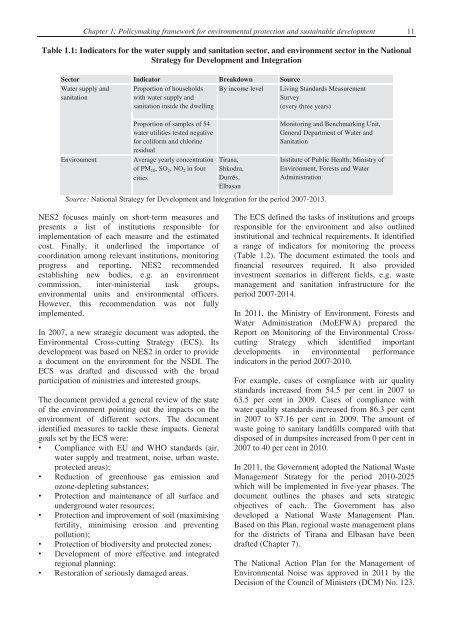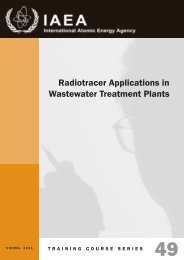Second Environmental Performance Review of Albania
Second Environmental Performance Review of Albania
Second Environmental Performance Review of Albania
Create successful ePaper yourself
Turn your PDF publications into a flip-book with our unique Google optimized e-Paper software.
Chapter 1: Policymaking framework for environmental protection and sustainable development11Table 1.1: Indicators for the water supply and sanitation sector, and environment sector in the NationalStrategy for Development and IntegrationSector Indicator Breakdown SourceWater supply andBy income levelsanitationEnvironmentProportion <strong>of</strong> householdswith water supply andsanitation inside the dwellingProportion <strong>of</strong> samples <strong>of</strong> 54water utilities tested negativefor coliform and chlorineresidualAverage yearly concentration<strong>of</strong> PM 10 ,SO 2 ,NO 2 in fourcitiesTirana,Shkodra,Durrģs,ElbasanLiving Standards MeasurementSurvey(every three years)Source: National Strategy for Development and Integration for the period 2007-2013.Monitoring and Benchmarking Unit,General Department <strong>of</strong> Water andSanitationInstitute <strong>of</strong> Public Health; Ministry <strong>of</strong>Environment, Forests and WaterAdministrationNES2 focuses mainly on short-term measures andpresents a list <strong>of</strong> institutions responsible forimplementation <strong>of</strong> each measure and the estimatedcost. Finally, it underlined the importance <strong>of</strong>coordination among relevant institutions, monitoringprogress and reporting. NES2 recommendedestablishing new bodies, e.g. an environmentcommission, inter-ministerial task groups,environmental units and environmental <strong>of</strong>ficers.However, this recommendation was not fullyimplemented.In 2007, a new strategic document was adopted, the<strong>Environmental</strong> Cross-cutting Strategy (ECS). Itsdevelopment was based on NES2 in order to providea document on the environment for the NSDI. TheECS was drafted and discussed with the broadparticipation <strong>of</strong> ministries and interested groups.The document provided a general review <strong>of</strong> the state<strong>of</strong> the environment pointing out the impacts on theenvironment <strong>of</strong> different sectors. The documentidentified measures to tackle these impacts. Generalgoals set by the ECS were:• Compliance with EU and WHO standards (air,water supply and treatment, noise, urban waste,protected areas);• Reduction <strong>of</strong> greenhouse gas emission andozone-depleting substances;• Protection and maintenance <strong>of</strong> all surface andunderground water resources;• Protection and improvement <strong>of</strong> soil (maximisingfertility, minimising erosion and preventingpollution);• Protection <strong>of</strong> biodiversity and protected zones;• Development <strong>of</strong> more effective and integratedregional planning;• Restoration <strong>of</strong> seriously damaged areas.The ECS defined the tasks <strong>of</strong> institutions and groupsresponsible for the environment and also outlinedinstitutional and technical requirements. It identifieda range <strong>of</strong> indicators for monitoring the process(Table 1.2). The document estimated the tools andfinancial resources required. It also providedinvestment scenarios in different fields, e.g. wastemanagement and sanitation infrastructure for theperiod 2007-2014.In 2011, the Ministry <strong>of</strong> Environment, Forests andWater Administration (MoEFWA) prepared theReport on Monitoring <strong>of</strong> the <strong>Environmental</strong> CrosscuttingStrategy which identified importantdevelopments in environmental performanceindicators in the period 2007-2010.For example, cases <strong>of</strong> compliance with air qualitystandards increased from 54.5 per cent in 2007 to63.5 per cent in 2009. Cases <strong>of</strong> compliance withwater quality standards increased from 86.3 per centin 2007 to 87.16 per cent in 2009. The amount <strong>of</strong>waste going to sanitary landfills compared with thatdisposed <strong>of</strong> in dumpsites increased from 0 per cent in2007 to 40 per cent in 2010.In 2011, the Government adopted the National WasteManagement Strategy for the period 2010-2025which will be implemented in five-year phases. Thedocument outlines the phases and sets strategicobjectives <strong>of</strong> each. The Government has alsodeveloped a National Waste Management Plan.Based on this Plan, regional waste management plansfor the districts <strong>of</strong> Tirana and Elbasan have beendrafted (Chapter 7).The National Action Plan for the Management <strong>of</strong><strong>Environmental</strong> Noise was approved in 2011 by theDecision <strong>of</strong> the Council <strong>of</strong> Ministers (DCM) No. 123.
















